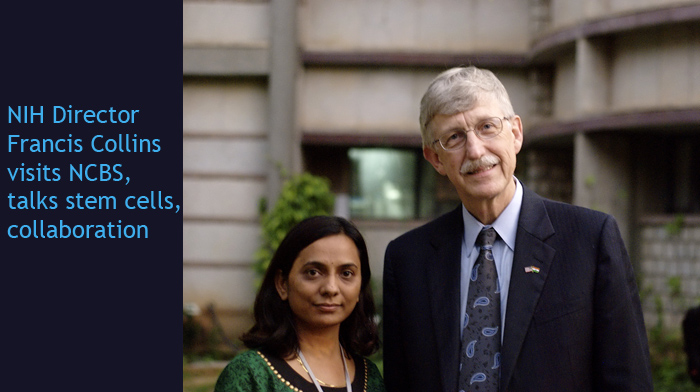"Rock Star of Science" Francis Collins visits NCBS

Francis Collins, NIH Director with Shravanti Rampalli, faculty member at inStem. Photo: Vaibhhav Sinha
| "It's a rare paper that gives you a chill of excitement. This was one of them." Francis Collins, Director of the National Institutes of Health, USA talks about reading the first report of "induced pluripotent stem cells", a technique that has the potential to create stem cells from the patient's own cells |
Like a new captain for a sinking Titanic, Francis Collins came aboard NIH at a time when the world was drowning in the late-2000's recession. It was a challenging time for US biomedical research, and leading the National Institutes of Health is a tough job. "The Director deals with the Directors of each NIH Institute: Powerful scientists, strong-willed with their own strengths, priorities, biases and institutional limitations", explains NCBS's VijayRaghavan, "To conduct an orchestra of cats is never easy."
But Collins had the resume to make one believe he could turn things around. A physical chemist turned biologist, Collins has pioneered the development of some of the most significant techniques of molecular biology, such as chromosome jumping and positional cloning. Using these methods, Collins and his team helped to identify the key genes involved in cystic fibrosis. Later, he went on to shepherd the International Human Genome Sequencing Consortium, and led the public side of the effort that first described the human genome in 2000.
Visiting India for the first time, Collins' talk at NCBS emphasised how NIH wants to build relationships with the growing Indian scientific community. More specifically, he also stressed that NIH wants to actively collaborate with the stem cell research centre at NCBS, and with institutes in other parts of the country. With over 250 active grants from the NIH, India is one of the countries most frequently funded. On Monday, Collins is heading to Delhi to sign a 'letter of intent' with M.K. Bhan, Secretary of the Department of Biotechnology.
A large part of Collins' talk at NCBS was devoted to the therapeutic potential of stem cells to treat both common and rare diseases. His hopes for their use in regenerative medicine soared high after reading Yamanaka's first report on the reprogramming of pluripotent stem cells in mice. Even though these studies have not yet translated to medical success - there has not yet even been a single clinical trial - for Collins it is merely a matter of time. He noted that the slow progress has been due in part to an increased carefulness, and cost, in the scrutinising of any potential new medical therapy. Meanwhile the NIH has launched a big new initiative, the NIH-Centre for Regenerative Medicine, currently headed by Dr. Mahendra Rao. They want to take promising molecular findings beyond the petri dish, to the people.
In spite of the gravity of his topic, Collins impressed the full-house with his determination, optimism and occasional dose of humour. A consummate guitar-player himself, who has jammed with bands like Aerosmith, many of us were secretly hoping that art would soon meet science: that did not occur, but we did get to meet and hear a true "rock star" of science.
Comments
Post new comment